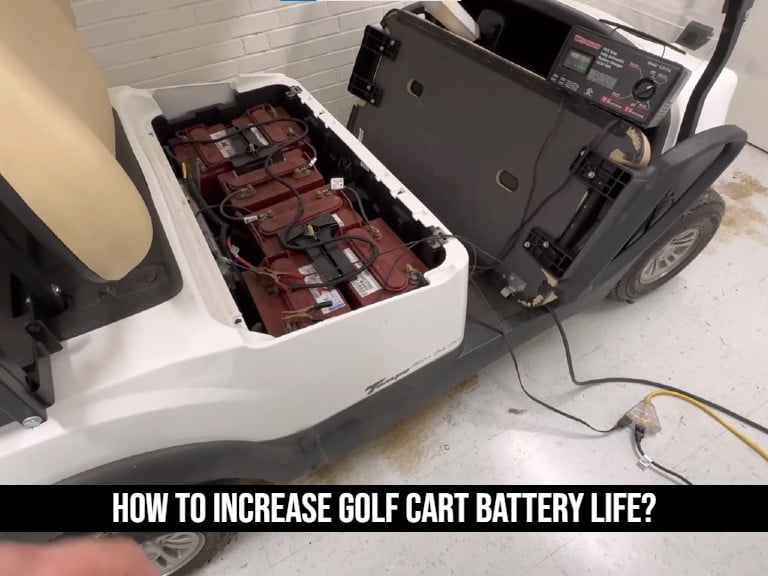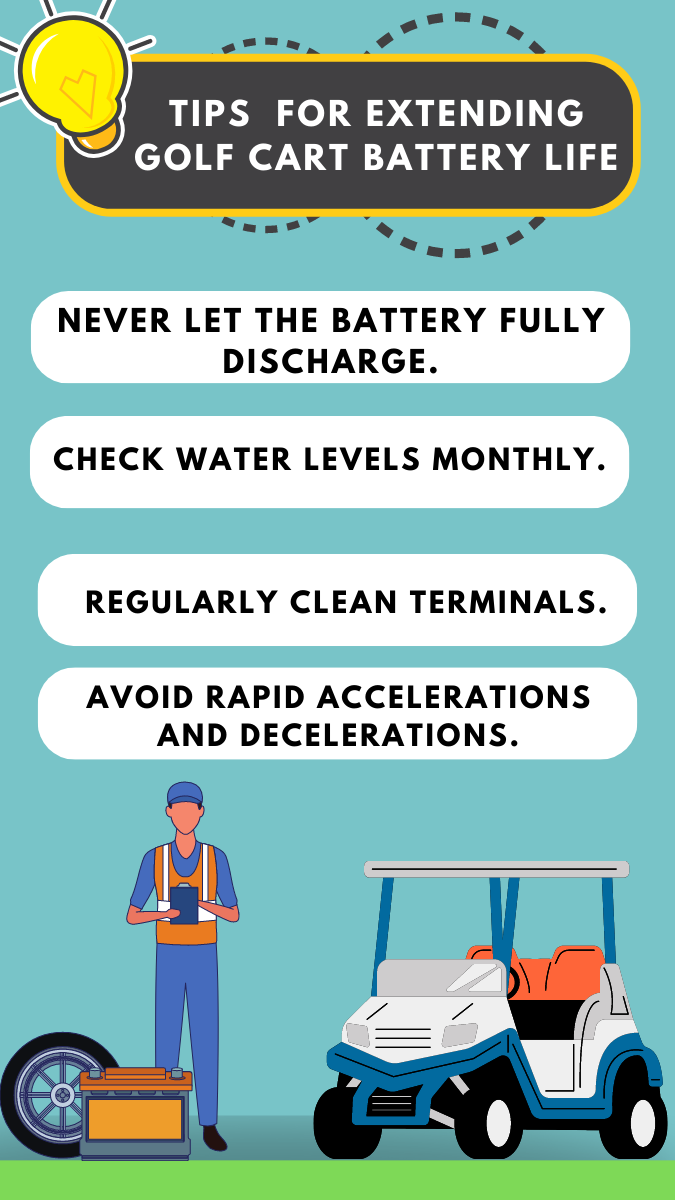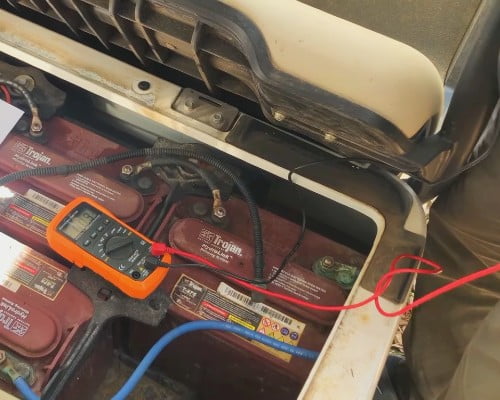
Golf carts, a staple on the green and a joyride for many, often face the inevitable challenge of battery depletion.
Ah, the frustration of a dying battery just when you’re about to make that perfect swing! But what if there was a way to extend that battery life, ensuring your cart is always ready for action?
Delving into the myriad of tips and tricks available, it’s evident that golfers are on a quest for longevity.
From understanding the nuances of battery maintenance to the little-known hacks, there’s a world of knowledge waiting to be uncovered.
Dive in as we unravel the secrets to giving your golf cart battery a longer, more efficient life. Let’s tee off to a journey of discovery!
10+ Essential Maintenance Tips for Prolonged Battery Life Of Golf Carts

Golf cart batteries are a significant investment, and maximizing their lifespan can save you both time and money in the long run. Proper care and maintenance are crucial to ensuring that your golf cart batteries serve you efficiently for years. Here are some practical tips to help you increase the life of your golf cart batteries:
1. Regular Charging
Always charge your golf cart batteries after each use. Avoid waiting until they are completely drained. Consistent and regular charging can significantly extend the battery’s life.
2. Avoid Deep Discharges
Deeply discharging your battery can strain and damage it. It’s recommended to recharge the battery when it reaches 50% discharge. Regularly running it down to a low charge can shorten its lifespan.
3. Watering
Golf cart batteries, especially lead-acid types, need to be topped up with distilled water. However, avoid overfilling them. It’s best to check the water levels at least once a month and only use distilled water to prevent mineral buildup.

4. Clean Battery Terminals
Corrosion can build up on the battery terminals over time. Use baking soda and water to clean the terminals regularly. This not only ensures a good connection but also prevents potential damage from corrosion.
5. Proper Storage
If you’re not using your golf cart for an extended period, ensure the batteries are fully charged and stored in a cool, dry place. Extreme temperatures, both hot and cold, can adversely affect battery life.
6. Regular Inspection
Periodically inspect your batteries for signs of damage, such as bulging, cracks, or leaks. Early detection of these signs can prevent further damage and potential hazards.
7. Use the Right Charger
Always use a charger that’s compatible with your golf cart battery specifications. A mismatched charger can either undercharge or overcharge the battery, both of which can reduce its lifespan.
8. Limit Heavy Loads
Overloading your golf cart can strain the batteries, leading to reduced performance and lifespan. Always adhere to the manufacturer’s recommended weight limits.
9. Maintain Tire Pressure
Underinflated tires can increase the load on the battery, causing it to work harder. Make sure the tire pressure is maintained regularly.
10. Avoid Quick Charging
While quick chargers can be convenient, they can also generate more heat and strain the battery. It’s always best to allow the battery to charge slowly and completely.
Additionally, there are other products available that claim to help with battery repair and maintenance. One such product is a golf cart battery repair liquid. To learn more about its effectiveness and how it works, read our detailed analysis here.
Advanced Golf Carts Battery Care Techniques
Maintaining the health of your golf cart battery is crucial for its longevity and performance. Here are some advanced techniques to ensure your battery remains in top shape:
1. Using a Hydrometer for Battery Health

A hydrometer is a tool used to measure the specific gravity of the battery’s electrolyte. This measurement can indicate the state of charge of the battery.
A fully charged battery will have a higher specific gravity compared to a discharged one.
Regularly checking the specific gravity with a hydrometer can help identify if the battery is being properly charged and can also indicate the presence of any dead cells.
It is important to check the specific gravity of each cell as a single bad cell can affect the overall performance of the battery.
2. Voltage Tests: Identifying Weak Batteries
Voltage tests are essential to identify weak or failing batteries.
A fully charged golf cart battery should have a voltage of around 12.6 volts or higher. If the voltage is lower than 12 volts, it indicates that the battery is not holding a charge well and may need to be replaced.
It is recommended to perform voltage tests when the battery is fully charged and after it has been used for a round of golf to get accurate readings.
When Should You Replace Your Golf Cart Battery? | Key Signs to Look For!
Reduced Capacity and Swelling
One of the most critical signs that it’s time to replace your golf cart battery is reduced capacity. If your golf cart doesn’t seem to have as much power as it used to, or takes longer to reach full charge, it’s a sign of reduced capacity.
Additionally, swelling or leakage from the battery is a red flag that indicates the battery should be replaced immediately.
Swelling occurs when the battery is damaged, overcharged, or exposed to high temperatures. It is crucial to address these issues promptly to avoid further damage and ensure the safety of the golf cart and its users.
Uneven Voltage Readings: What It Means

Another sign that it’s time to replace your golf cart battery is low or uneven voltage readings. This could be an indication of a failing battery.
Each cell of the batteries in a golf cart works together to supply power to the entire system.
The replacement of only one or two cells can result in an imbalance, which may result in a reduction in performance as well as premature failure of the pack.
It is recommended to replace the entire battery pack instead of individual cells to ensure optimal performance.
How Weather Conditions Impact Golf Carts Battery Life?
Weather can impact battery lifespan, especially in extreme temperatures for golf carts. Here are some key ways in which weather conditions impact battery life:
| Weather Condition | Impact on Battery Life |
|---|---|
| Extreme Temperature | Can cause electrolytes to freeze or evaporate, leading to permanent damage or a decrease in battery capacity. |
| High Humidity | This can lead to condensation on the battery terminals, causing corrosion and reducing the battery’s ability to hold a charge. |
| Precipitation | This can lead to corrosion of the battery terminals and connections. |
Final Thoughts!
By adhering to the essential maintenance tips and advanced battery care techniques outlined, you can significantly enhance the lifespan of your golf cart battery.
A properly maintained battery can last up to 50% longer, saving you significant amounts of money over the long term.
For example, a well-maintained golf cart battery that usually lasts 4-5 years could potentially last 6-7 years, saving around $600-$800 in replacement costs.
Ultimately, the secret to extending golf cart battery life lies in regular maintenance, timely inspections, and a comprehensive understanding of the effects of external factors such as weather conditions.

Bob is a golf equipment expert with a wealth of knowledge about the latest and greatest golfing gear. Bob is our Lead Product Reviewer and provides in-depth reviews and recommendations on the best equipment for golfers of all levels. He takes a hands-on approach to testing, using his extensive experience on the course to provide the most accurate and reliable product recommendations. Join Our Team!
